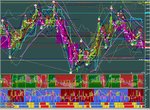An interesting point that you make Masnachu and one that I've been thinking about of late. Given that TA is all about trying to identify, amongst other things, price patterns that will hopefully repeat (on the basis that human psychology dictates that
Bare in mind when reading it's the end of the trading day, I'm usually a tad phased and random at this point
😉😕
The influence is going to come from things like weightings and sector/industry groups (obviously index constituents aren't all moving around randomly) and current perceptions towards those sectors etc. Predictability is from human behavior as you said.
Generally:
Which stocks are, or which stocks will be, having an effect on an index, depends on
which sectors are in, or are coming into 'fashion' (due to macro trends) at the time, in other words, what's the overall prevailing thinking of the market, i.e. are we going into/out of a recession ? or is the current economic trend continuing ? which part of the cycle are we in i.e. which stage are we in - early, middle or late ? (The old business cycle/sector rotation theory stuff). Get this right and longer term assumptions on the direction of the indices (markets in general) should prove profitable.
While the above is more longer term investment orientated (what will be, rather than what is) it's all still applicable to shorter term trading, but with current and recent news flow and their short term effects on sectors replacing the longer term macro economic trends above.
Obviously it's the underlying stocks that drive an index, (but what the index is doing also plays a part in decision making process with regards buying and selling in the constituent stocks, hmmm Reflexivity anybody ?
😉 )
So does analysing stocks/sector indices help give clues to the direction of the overall index ? Yes and , for me personally , no :whistling
With regards to the short term movements, people do look at the underlying stocks/sectors of an index in order to help them determine the possible direction of the index (even do it myself. but very rarely, an example would be when the financial crises started kicking off , watching the BKX US banking sector index)
The main reason I don't do it myself (for the sort term at least), is that it was adding another layer of complexity to the decision making process without a corresponding increase in the percentage of profitable trades. Sometimes it helped, but most of the time it was getting in the way.
As we know with trading (TA etc), no one
knows what the outcome will be before hand. It's normally a case of , Is it what I think I'm seeing or isn't it? will it do what I think it's gong to do or won't it ? You never know , you just have to go with it, see how it pans out,
When I looked at the underlying stocks/sectors, instead of getting answers/hints with regards to the future direction of the index, I was just ending up with more of the same, is it/isn't it , will it/won't it as I did with the index, In other words just more confusion. So now I just trade the index itself.
Longer term with regards to
trying to get a picture of the larger macro trends and any possible signs of change, I do take a look at constituent stocks , looking for any info like, leaders loosing influence , topping/bottoming formations (depending on bull/bear market etc) in the heaviest weightings , rotation out of and into various sectors etc, trying to look for clues (same thing though, usually end up confusing myself
😱)

